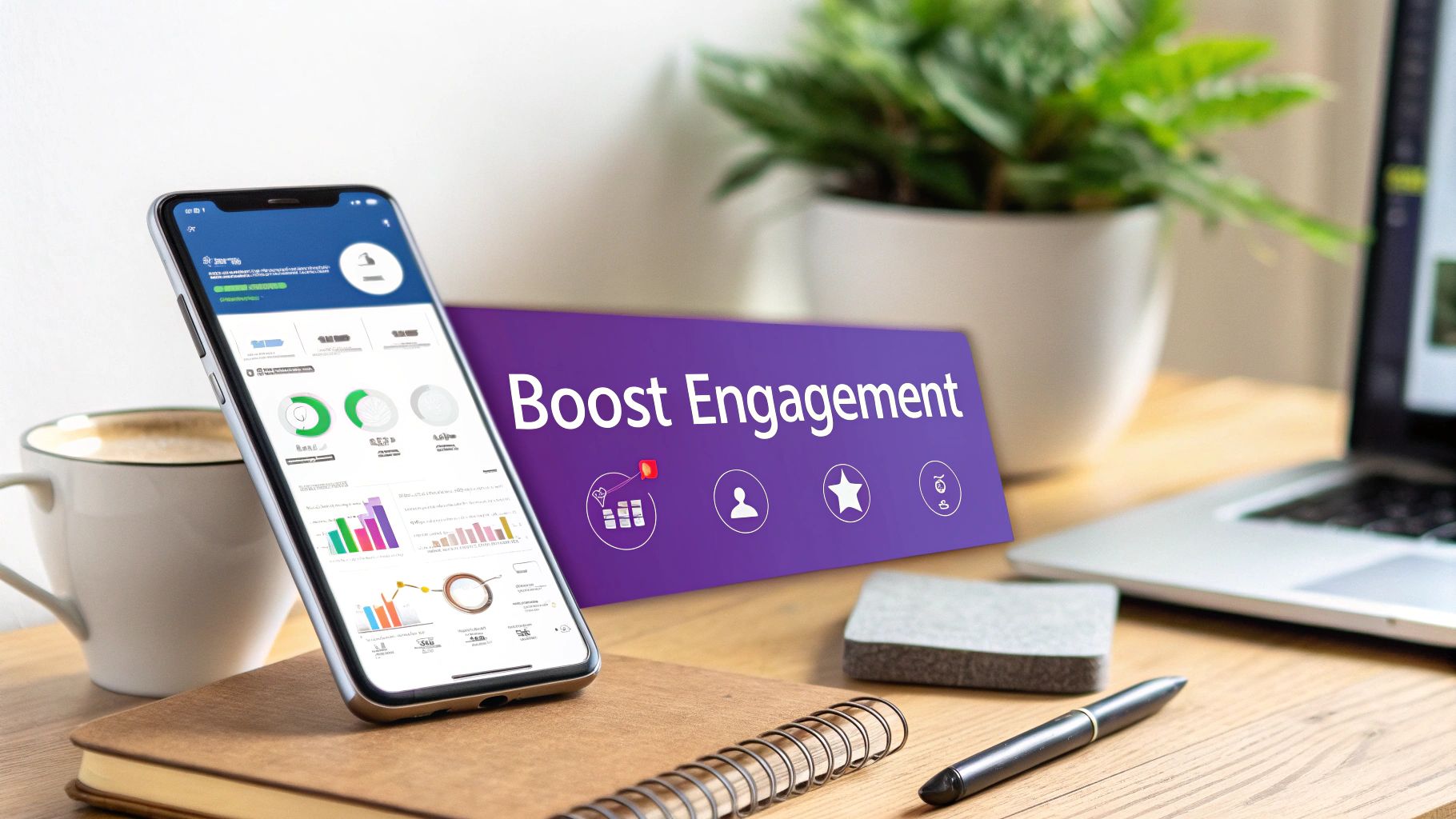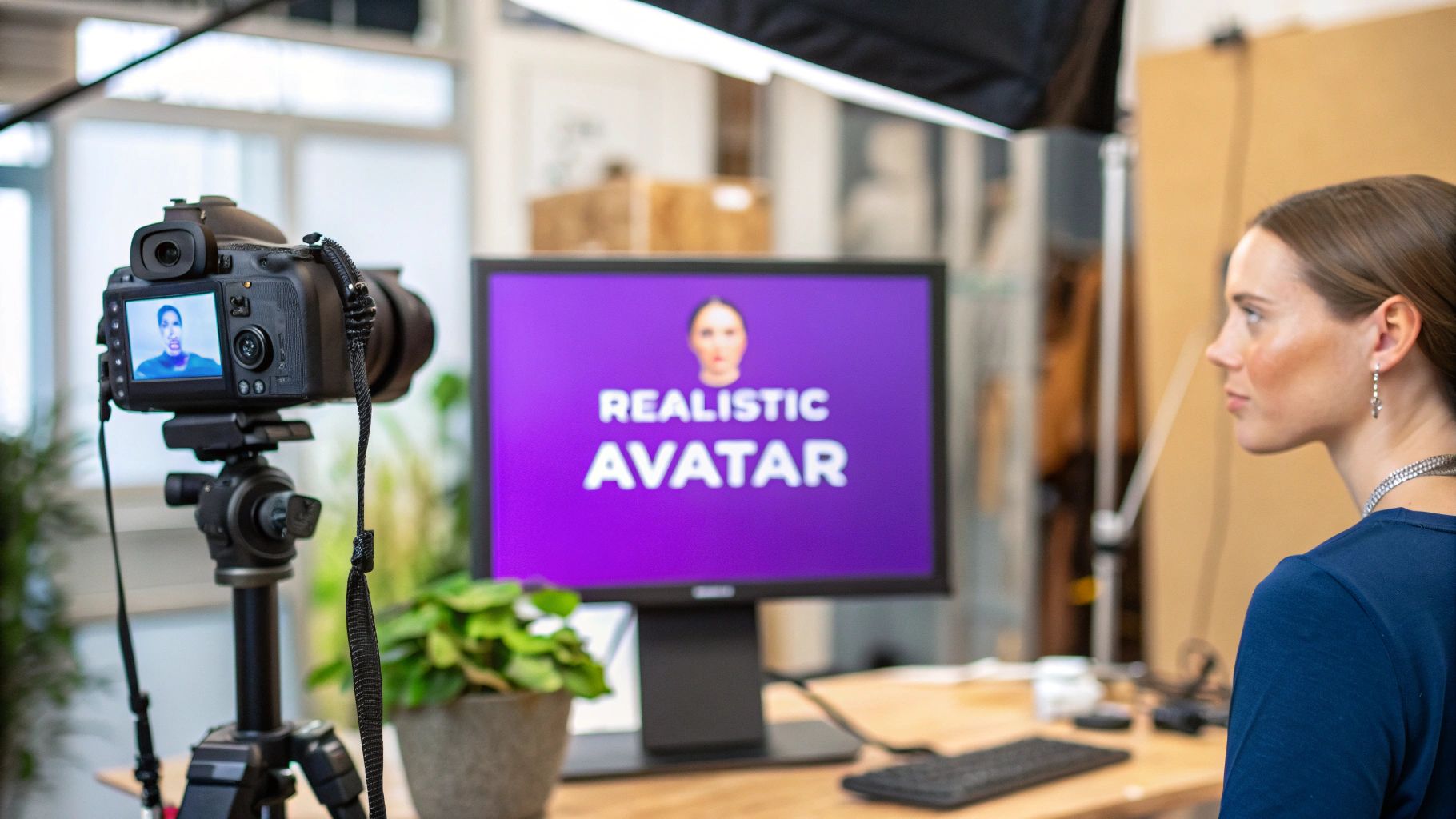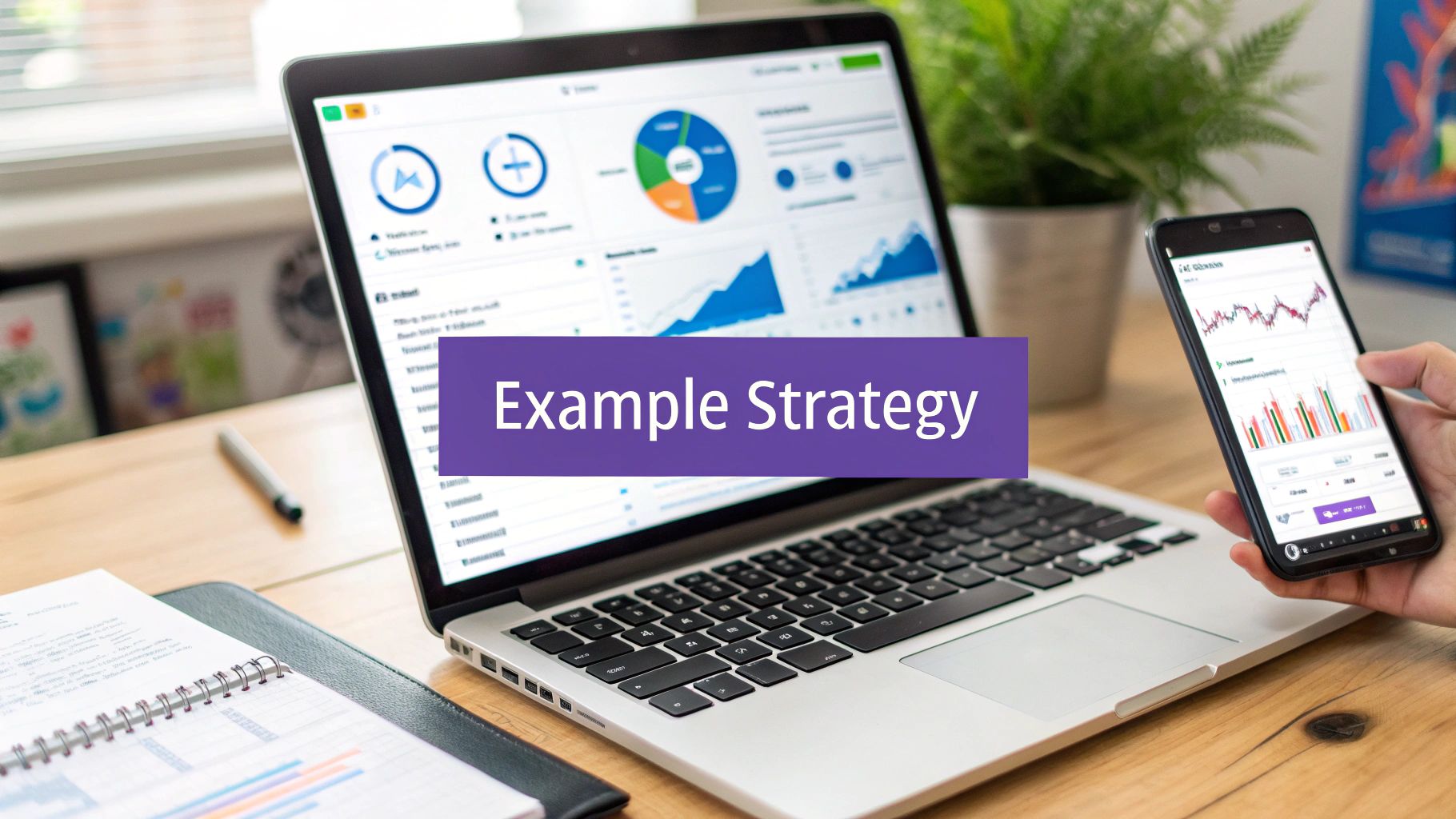Social Media for Entrepreneurs Your Ultimate Guide
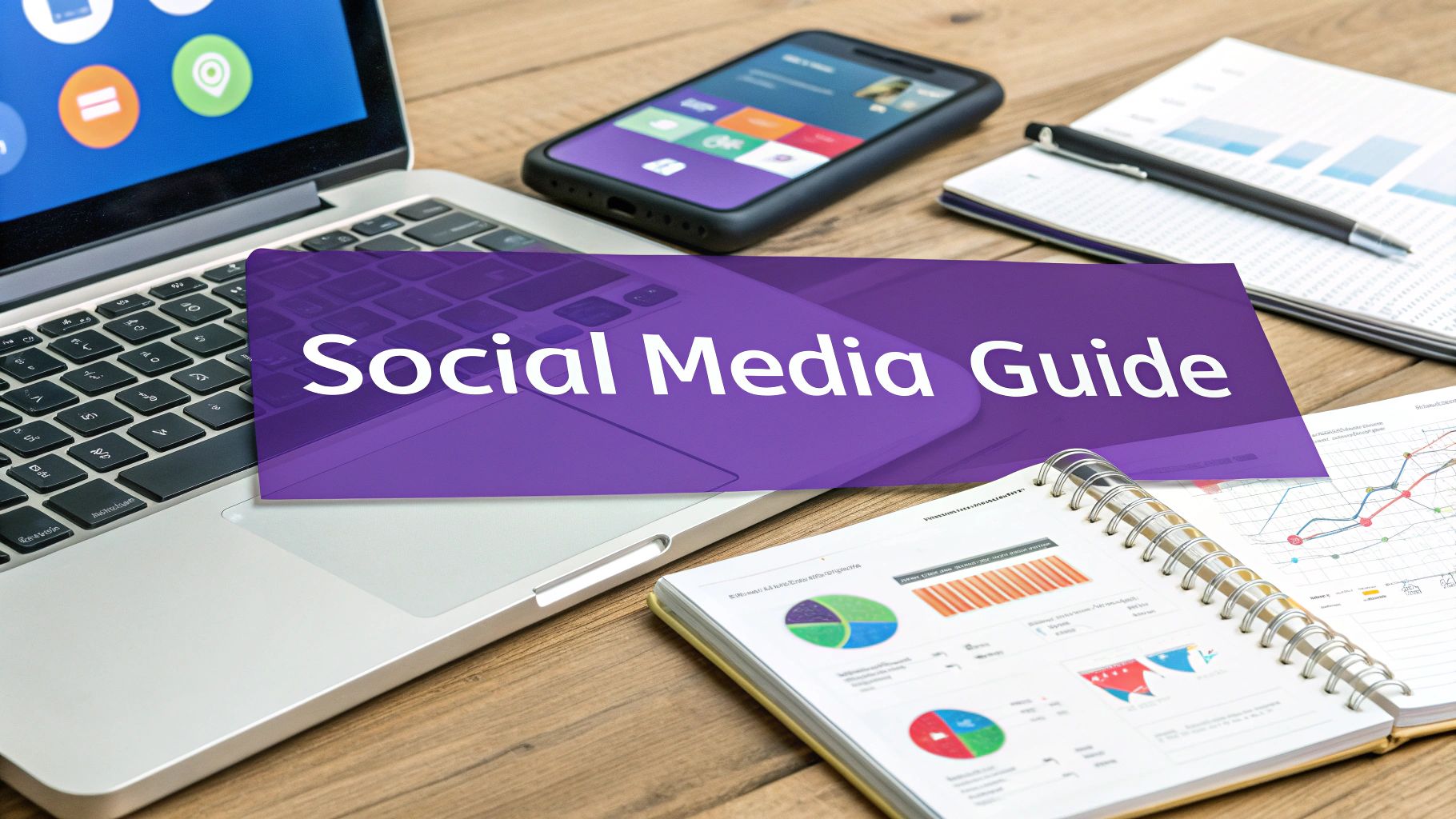
Let's be honest, for most entrepreneurs, social media feels like just another task on an endless to-do list. But what if you stopped seeing it as a chore and started seeing it for what it really is? It’s the modern-day town square where your ideal customers are already hanging out. It's your 24/7 storefront, your virtual networking event, and your customer service hub—all rolled into one.
Why Social Media Is an Entrepreneur's Unfair Advantage

For a new business, getting noticed isn't just a goal; it's oxygen. Without it, even the most brilliant ideas suffocate before they have a chance. This is where social media gives you a serious edge, offering a direct line to billions of people and leveling the playing field against bigger, more established competitors.
Think of it like this: launching a business today without a social media presence is like opening a shop on a hidden backstreet with no sign. You might have the best product in the world, but if no one knows you exist, does it even matter? Social media puts your business right on Main Street, where the foot traffic is global and never stops.
The New Digital Main Street
Today, people don't just scroll through social media for fun. They use it to discover new products, research brands, and connect with the people behind them. This simple fact transforms these platforms from a "nice-to-have" marketing channel into a core business function. It's the most direct path to building a brand from the ground up.
The numbers don't lie. With over 5 billion active users spending an average of 143 minutes per day on these platforms, the opportunity to connect is massive. It's no surprise that over 96% of small businesses already use social media as a key part of their strategy—it’s that fundamental. For a deeper dive, you can explore the compelling business case for social media and see the stats for yourself.
The real job of social media for an entrepreneur is to turn attention into trust. When you consistently show up, provide real value, and talk to people like a human, you build relationships at a scale that was once unimaginable.
More Than Just Marketing
A smart social media plan delivers benefits that go way beyond just running a few ads. It’s a versatile tool that can fuel growth across your entire business.
Before we dive deeper, let's quickly summarize the core benefits every entrepreneur should know.
Top Social Media Benefits for Entrepreneurs at a Glance
| Benefit | Key Impact on Your Business |
|---|---|
| Direct Customer Feedback | Get raw, unfiltered insights to improve your products in real-time. |
| Community Building | Create a tribe of loyal fans who become your best advocates. |
| Authentic Brand Storytelling | Share your mission and the human side of your business to build connection. |
| Cost-Effective Reach | Access a highly targeted audience without breaking the bank. |
As you can see, the advantages are about much more than just getting your name out there. Let's break down a few of these.
- Direct Customer Feedback: You get unfiltered access to what your audience thinks, wants, and needs. This lets you adapt and improve your products and services on the fly.
- Community Building: Social platforms are perfect for building a tribe of loyal followers who not only buy from you but become vocal advocates for your brand.
- Authentic Brand Storytelling: This is your stage. It's where you share your "why," your mission, and the human side of your business, creating a much deeper connection with your audience.
- Cost-Effective Reach: Compared to old-school advertising, social media offers an incredibly low-cost way to reach a very specific audience, making it a dream for bootstrapped startups.
Ultimately, social media for entrepreneurs isn't about chasing vanity metrics or posting whenever you remember. It's about strategically building a digital footprint that attracts customers, builds credibility, and creates a sustainable engine for growth.
Choosing the Right Platforms for Your Business
Let's get one thing straight: the biggest mistake entrepreneurs make with social media is trying to be everywhere at once. It's a classic case of spreading yourself too thin, and it’s a fast track to burnout with little to show for it.
Think of it like fishing. You wouldn't cast a net for deep-sea tuna in a shallow creek, right? You go where the fish are. Your goal is to find the digital "hangouts" where your ideal customers are most active and then use the right "bait" to get their attention. For entrepreneurs juggling a million tasks, this kind of strategic focus isn’t just a nice-to-have—it’s everything. Nailing one or two platforms will always beat having a weak presence on five or six.
Match Your Audience to Platform Demographics
First things first: go where your customers are. It’s a simple rule, but it’s the foundation of any successful social media plan. Every network has its own unique vibe, user base, and set of behaviors. If you're selling high-end B2B consulting services, the chaotic, trend-driven world of TikTok probably isn’t your best bet. On the flip side, a fashion brand that ignores Gen Z’s favorite app is leaving a massive opportunity on the table.
Here’s a quick rundown of the major players:
- LinkedIn: This is the undisputed champion of B2B networking. It’s crawling with professionals, decision-makers, and industry leaders. If you’re a consultant, run a service-based business, or want to build professional authority, LinkedIn is your playground.
- Instagram: A visual-first powerhouse, with a strong user base between 18-34 years old. It's the perfect spot for brands that look good on camera—think fashion, food, travel, and design. It's also become a go-to for discovering local businesses.
- Facebook: With nearly 3 billion monthly active users, Facebook has the widest demographic reach, hands down. It's a versatile pick for B2C businesses targeting different age groups, especially for building communities and promoting local events or services.
- X (formerly Twitter): This is the home of real-time conversation. It moves fast and is built for news, quick takes, and bite-sized updates. It's a great fit for tech companies, journalists, and any brand that needs to plug into timely industry chatter.
- TikTok: The epicenter of short-form video, dominated by a younger audience. If you can create authentic, entertaining, and trend-savvy videos, you can find explosive growth on TikTok.
- Pinterest: Think of it less like a social network and more like a visual search engine. Users come here to actively look for inspiration—from home decor to recipes. This gives your content a much longer shelf life than on other platforms.
Don’t choose a platform just because it's popular; choose it because your target customer lives there. A small, hyper-engaged audience on the right platform is worth infinitely more than a massive, indifferent one on the wrong one.
Match Your Content to the Platform's Vibe
Once you know where your audience is, the next question is what kind of "bait" you’ll use. Every platform has its own native language. Trying to force content that doesn’t fit the local culture feels awkward, and both the algorithm and the users will sniff it out and ignore you.
For a clearer picture, I've put together a table to help you map your goals to the right platform and content style.
Platform Selection Matrix for Entrepreneurs
This matrix breaks down the major platforms to help you decide where to invest your time and energy. Think of it as a cheat sheet for making a smart, informed choice.
| Platform | Primary Audience | Best For (Content Type) | Entrepreneurial Goal |
|---|---|---|---|
| Professionals, B2B Decision-Makers (30-65+) | Articles, Text Posts, Professional Video | Build Authority, B2B Lead Gen, Networking | |
| Gen Z & Millennials (18-34) | Reels, Stories, High-Quality Photos | Build Brand, Showcase Products, Community Engagement | |
| Broad (All Ages, esp. 35+) | Video, Live Streams, Community Posts, Ads | Local Business, Community Building, B2C Sales | |
| X (Twitter) | Tech-savvy, News-focused (30-49) | Short Text, Memes, Real-time Updates | Public Relations, Customer Service, Industry News |
| TikTok | Gen Z & Younger Millennials (16-24) | Short-form Entertainment & Educational Videos | Brand Awareness, Trend-jacking, User-Generated Content |
| Female-dominated, Planners & Shoppers (30-49) | Infographics, Guides, Product Pins | Drive Website Traffic, E-commerce Sales |
This should give you a solid starting point. By aligning your goals with the platform's strengths, you're setting yourself up for success instead of fighting an uphill battle.
Be Realistic About Your Resources
Okay, time for some real talk. You need to be brutally honest with yourself about what you can actually do. Are you a fantastic writer but cringe at the thought of being on camera? Then LinkedIn or a blog might be your jam. Do you love whipping up quick, funny videos on your phone? Instagram Reels or TikTok could be where you shine.
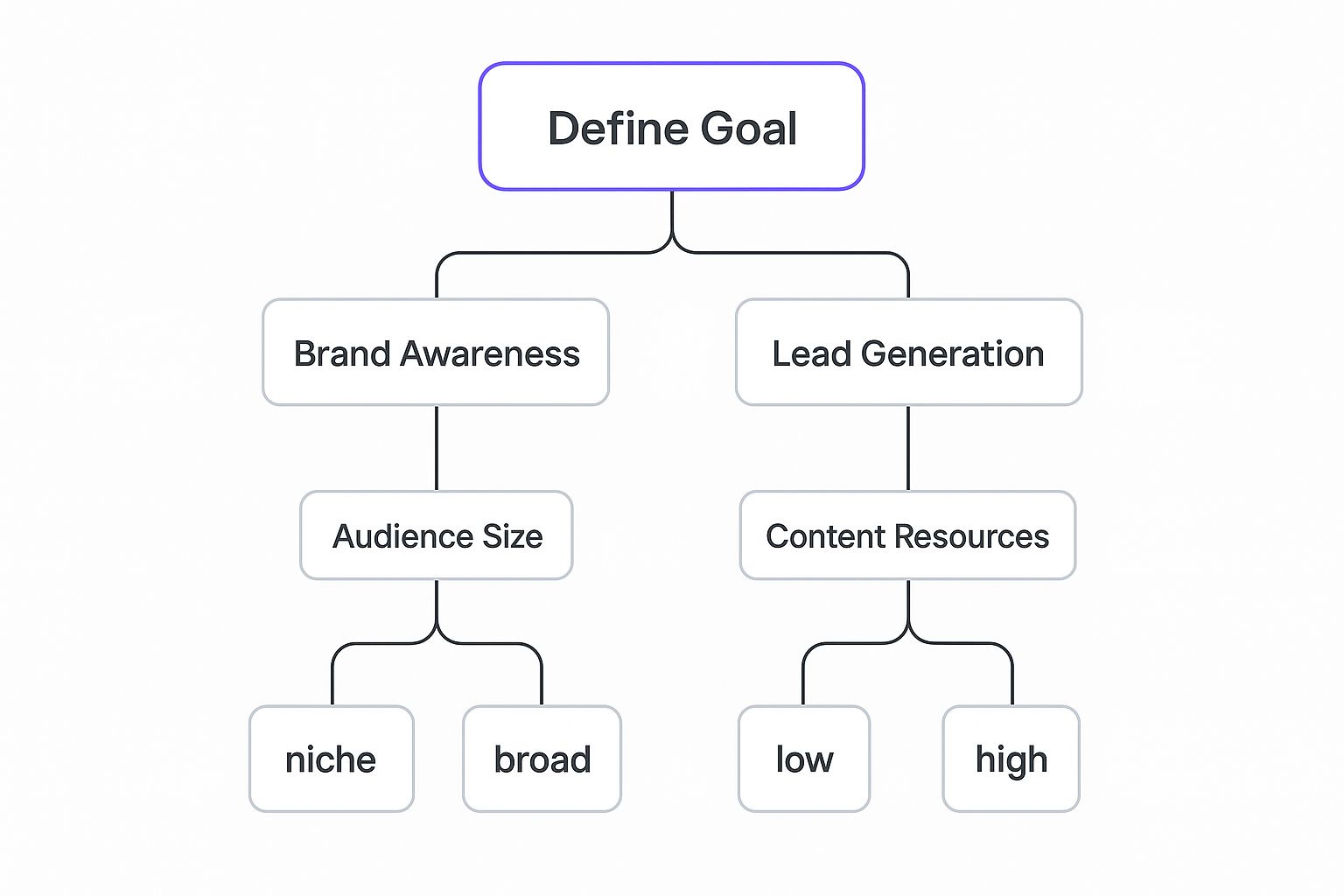
As a solo founder or a small team, you simply cannot do it all. The point of using social media for entrepreneurs isn't to add another full-time job to your already-packed schedule. It's about making smart, sustainable choices that build momentum over time.
Pick the 1-2 platforms that are the best fit for your audience, your content strengths, and your available time. Get good at them, build a real community, and only then should you even think about expanding.
Developing a Content Strategy That Actually Converts

Great content is the fuel for your social media engine, but without a clear strategy, you’re just creating noise. For entrepreneurs, a solid plan is what separates random posts from a system that turns followers into loyal customers.
Think of your content strategy as a balanced diet for your audience. You can't just serve dessert—promotional posts—all the time, or your followers will tune you out. An engaging feed needs a mix of different types of value to keep them coming back. This is where having a repeatable blueprint becomes your secret weapon.
The Four Pillars of Engaging Content
To build a content engine that lasts, it helps to think in terms of four key pillars. This simple framework ensures you’re not just selling but also building relationships, establishing authority, and keeping things interesting. A smart approach to social media for entrepreneurs involves a strategic mix of all four.
- Educational Content: This is where you teach your audience something useful. Share your expertise, solve a common problem they face, or offer a unique insight they can’t find anywhere else. This pillar establishes you as a trusted expert.
- Inspirational Content: Share your own journey, customer success stories, or motivational ideas that connect with your brand’s mission. This type of content resonates on an emotional level and builds real brand affinity.
- Entertaining Content: Show the human side of your business. Use a little humor, share behind-the-scenes glimpses, or jump on engaging trends to make your brand more relatable and memorable.
- Promotional Content: This is where you directly talk about your products or services. When it’s balanced with the other three pillars, promotional content feels natural and welcome, not pushy or aggressive.
By rotating through these pillars, you create a dynamic content calendar that delivers consistent value and prevents your audience from getting bored. It’s a simple, balanced approach that’s crucial for long-term growth.
Brainstorming Ideas That Resonate
Coming up with fresh content ideas can feel like a chore, but it doesn't have to be. Instead of waiting for a lightning bolt of inspiration, you can build a system for generating topics that you know will land.
The best place to start? Just listen. Pay close attention to the questions your customers ask, the comments they leave, and the pain points they discuss in online forums. These are direct requests for content. You can also use tools like AnswerThePublic to discover what your audience is searching for, giving you a goldmine of proven topics.
Your best content ideas won't come from a boardroom; they'll come from the comment section. Pay attention to the language your audience uses and the problems they're trying to solve—that's your content gold.
Once you have a list of potential ideas, you can map them back to the four content pillars. For example, a customer question about a tricky feature can become an educational tutorial. A heartfelt testimonial can become an inspirational post. This simple process ensures you always have a backlog of relevant ideas ready to roll.
Weaving Your Brand Story into Every Post
Your brand story isn't just about how you started; it's the unique perspective, values, and personality that define your business. Consistently weaving this narrative into your content is what turns a generic social feed into a powerful brand presence.
To do this well, ask yourself these questions before you hit "post":
- Does this content reflect our core mission and values?
- Is the tone of voice consistent with our brand’s personality?
- Does this post reinforce what makes us different?
For instance, a sustainable fashion brand might share educational content on fabric sourcing, inspirational stories about its ethical manufacturing partners, and entertaining behind-the-scenes videos of its design process. Each post, regardless of its pillar, reinforces the brand’s commitment to sustainability.
This narrative consistency is what helps you stand out. When followers understand who you are and what you stand for, they're far more likely to trust you and, eventually, buy from you. Your content becomes more than just information—it becomes an extension of your brand, turning your feed into a destination that attracts and converts the right people. Tools like MakerBox can even help you maintain this consistent brand voice by generating content that aligns with your chosen professional, creative, or casual tone.
How to Build an Engaged Community From Scratch
Likes and follows are nice, but for entrepreneurs, they’re just vanity metrics. The real gold isn't in a high follower count; it's buried in the rich soil of an engaged community. Think of it like this: you can either broadcast to a faceless crowd or host a great party. Your job is to be the host—make people feel welcome, spark conversations, and help them connect with each other.
A truly engaged community is one of your most powerful business assets. It's a built-in focus group that gives you instant feedback, a volunteer marketing team that champions your work, and a loyal customer base that will stick with you through just about anything. But this doesn't happen by accident. It requires a deliberate shift from talking at your audience to talking with them.
Spark Meaningful Conversations
The easiest way to get people talking is to ask them something interesting. Instead of just posting announcements, start asking thoughtful questions that your audience actually wants to answer. Go beyond the generic "what do you think?" and get specific.
Think about your industry from your audience’s perspective. A business coach could ask, "What’s one productivity hack that actually saved you time this week?" A coffee brand might try, "Describe your perfect morning coffee ritual in three words." These questions are targeted, easy to answer, and create an opening for real human connection.
Your goal is to create a space where followers feel heard and valued. When someone takes the time to comment, they are giving you a gift—their attention. Acknowledging their contribution with a thoughtful reply is the single most effective way to encourage them to participate again.
This conversational approach is especially powerful for reaching younger, digitally-native consumers. Social media is a primary channel for discovery, with Instagram boasting 2 billion monthly users, the majority of whom (62.3%) are between 18 and 34. For entrepreneurs, this demographic is a goldmine. In fact, 67% of people aged 18-24 now use Instagram to find local businesses, proving how these platforms are becoming the new search engines for a massive consumer base. You can discover more about how different age groups use social networks to find brands.
Handle Feedback With Grace
Once your community starts buzzing, you'll inevitably get feedback—both good and bad. How you handle these moments defines your brand’s character and builds trust. Anyone can handle praise, but it’s your response to criticism that truly matters.
Here’s a simple, three-step process for handling negative comments gracefully:
- Acknowledge Publicly: Always respond right where the comment was posted. This shows everyone you're listening and not trying to hide from criticism.
- Empathize Sincerely: Start by acknowledging their frustration. A simple, "I'm sorry to hear you had this experience," goes a long, long way.
- Move Privately: Offer to solve the specific problem through a private channel, like DMs or email. This takes the back-and-forth out of the public square while showing you’re committed to making things right.
This method turns a potentially damaging moment into a public display of fantastic customer service.
Turn Followers into Insiders
People love feeling like they're part of something special. One of the best ways to create that "insider" feeling is by featuring your audience's own content, also known as User-Generated Content (UGC). When a customer posts a great photo with your product, ask for their permission to share it on your feed and always give them credit.
This is a triple win:
- You get authentic, high-quality content without lifting a finger.
- It acts as powerful social proof for other potential customers.
- The featured follower feels seen and appreciated, which deepens their loyalty.
By consistently sparking conversations, handling feedback like a pro, and celebrating your audience, you'll start to transform passive scrollers into a vibrant, supportive tribe. This is the real magic of social media for entrepreneurs—building relationships that ultimately build your business.
Measuring Social Media ROI Like a Pro
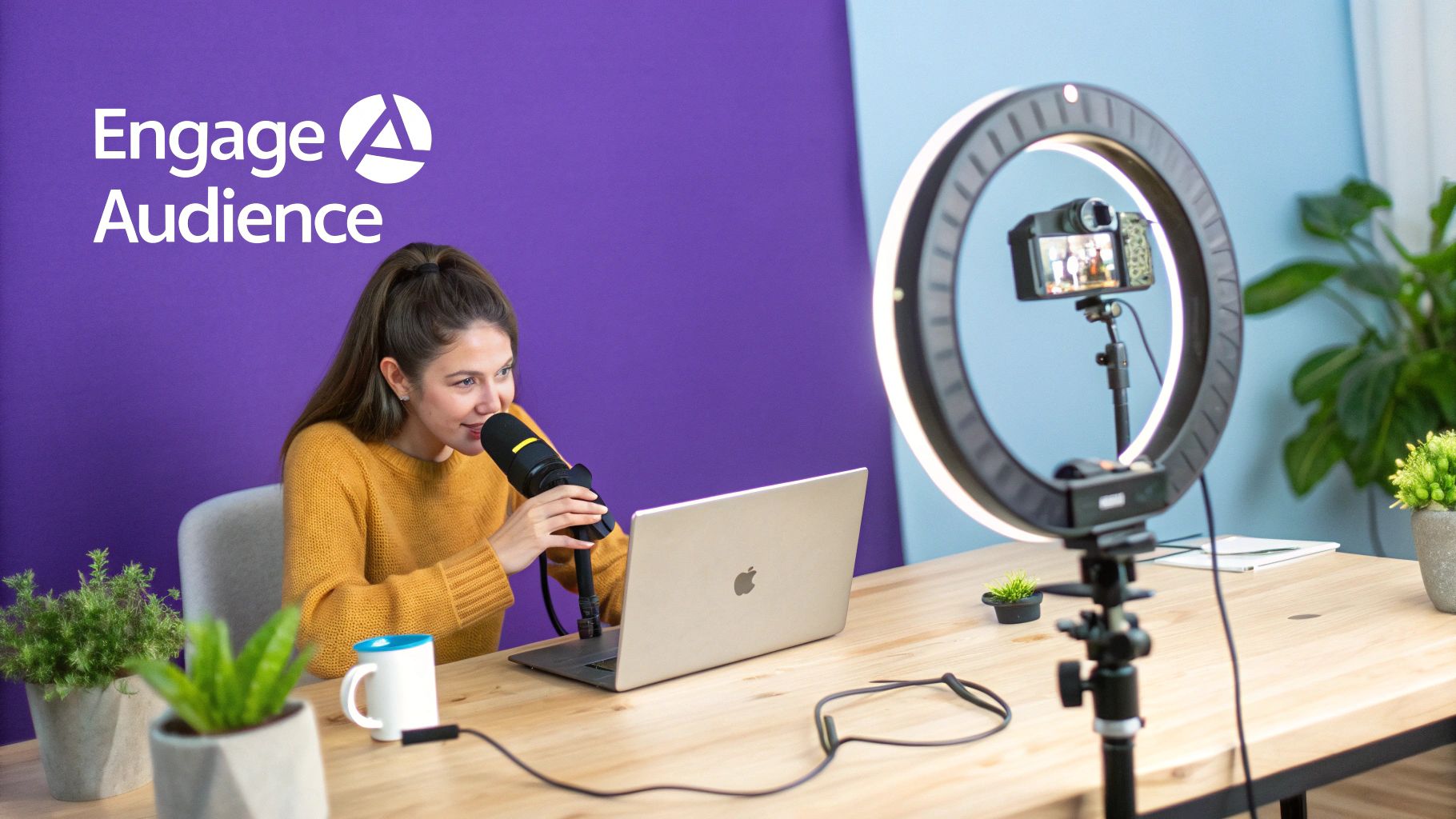
As an entrepreneur, you live by the numbers. You know your profit margins, your customer acquisition cost, and your runway down to the last dollar. So why should social media get a free pass?
Pouring time and money into platforms without knowing the return is a luxury you just can't afford. It’s time to stop treating social media like a guessing game and start measuring what actually matters. This is where the real growth happens.
Measuring social media ROI isn’t about wrestling with complex formulas or buying expensive software. It's simply about connecting your social media efforts directly to your business goals. Think of it as a feedback loop: your work creates data, that data shows you what's working, and you use those insights to make smarter moves. This is the heart of data-driven social media for entrepreneurs.
Moving Beyond Vanity Metrics
The first, and most important, step is to ignore the numbers that make you feel good but don't pay the bills. We call these vanity metrics. A huge follower count or a post with a thousand likes might give you a temporary ego boost, but they don't necessarily translate into business. It’s like having a store packed with people who are just window-shopping—it looks busy, but the cash register is empty.
Instead, you need to laser-focus on metrics that signal real intent and action. These are the numbers that have a direct line to your bottom line.
- Engagement Rate: This reveals how many people are actually interacting with your content (commenting, sharing, saving) relative to your audience size. It’s a powerful sign of content quality and community health.
- Click-Through Rate (CTR): This tells you how many people clicked a link in your post or bio. Think of it as the bridge connecting your social media island to your website, landing page, or product.
- Conversion Rate: This is the big one. It tracks the percentage of users who take a specific action you want after clicking your link—like signing up for a newsletter, downloading a freebie, or making a purchase.
By zeroing in on these action-oriented metrics, you start to see a much clearer picture of what’s driving real business results.
Setting Up a Simple Measurement System
You don’t need a data scientist or a complicated analytics dashboard to get started. Most social platforms have powerful, built-in tools that give you all the data you need. Your job is to create a simple system to track and make sense of it all.
“ROI is not just about the money you make; it’s about the value you create. For entrepreneurs, this could mean qualified leads, valuable customer feedback, or brand authority that closes deals faster.”
A straightforward way to do this is by setting specific, measurable goals for your social media. What are you trying to achieve? Drive traffic? Generate leads? Build brand awareness? Each goal will have its own key performance indicators (KPIs).
| Business Goal | Primary Social Media Metric to Track | How to Measure It |
|---|---|---|
| Increase Brand Awareness | Reach & Impressions | Use platform analytics to see how many unique users saw your content. |
| Generate Leads | Conversion Rate on Landing Pages | Track sign-ups from social media links using UTM parameters. |
| Drive Website Traffic | Click-Through Rate (CTR) | Monitor the percentage of users clicking links in your posts and profile. |
| Build Community | Engagement Rate | Calculate likes, comments, and shares as a percentage of your followers. |
This simple table helps you connect your daily social media grind to tangible business outcomes. Review these numbers weekly or monthly. Are your CTRs low? Maybe your calls-to-action need a tune-up. Is engagement dipping? It might be time to shake up your content strategy.
Ultimately, measuring ROI gives you the power to justify your time and investment. It transforms social media from a hopeful experiment into a predictable, optimizable engine for growth.
Adapting Global Trends for Local Market Success
Social media trends don’t stop at the border anymore. What’s working for a business halfway across the world can give you a powerful playbook for your own backyard. This is a huge advantage for entrepreneurs who are paying attention.
When you think globally, you start to see shifts in user behavior long before your local competitors do. It’s like being a chef who studies international cuisines—even if you only cook for your neighborhood, learning new techniques and ingredients will make every dish you create stand out from the crowd. You’ll uncover creative strategies you'd never find by just watching the businesses down the street.
From Global Insight to Local Action
A perfect example is how social media is weaving its way into our professional lives. Globally, about 38.3% of internet users now use social platforms for work-related activities. But here's where it gets interesting. The adoption rates show fascinating cultural and economic divides.
In a bustling emerging market like Nigeria, a staggering 65.2% of users are on social media for work. In Brazil, it’s over 50%. Contrast that with more established markets like the US (26.5%) or Japan, where it’s a mere 8.3%. You can dig deeper into these global social media work trends to see what they signal for different markets.
So, what does this actually mean for you?
- For High-Adoption Markets: If your business is in a place like Brazil or India (41%), your audience probably expects and even welcomes professional content on social media. This is your green light to be more direct with business messaging, tutorials, and behind-the-scenes content.
- For Lower-Adoption Markets: In places like the US or UK, you need to be a bit more subtle. The winning move here is to blend professional value with personal storytelling. Your content should feel less like an ad and more like a genuine conversation.
Adapting Tactics for Your Business
By studying these global patterns, you can cherry-pick strategies and give them a local twist. An entrepreneur in the UK might see the direct, educational style thriving in Nigeria and adapt it into a weekly "expert Q&A" on LinkedIn, where professional content is more at home.
Think of global trends as a menu of strategic options. You don't have to order every dish, but knowing what's available gives you the creative freedom to craft a perfect meal for your local customers.
Likewise, a founder in a market with high professional usage can draw inspiration from the community-building tactics of a US-based brand. They might start a Facebook Group for their niche, creating a space for connection that goes beyond just selling a product. This is what separates a reactive social media presence from a strategic one.
Ultimately, smart social media for entrepreneurs is about thinking globally so you can act decisively and effectively right where you are.
Got Questions? We’ve Got Answers.
Jumping into social media as an entrepreneur can feel like trying to drink from a firehose. You're not alone. Let's tackle some of the most common questions that come up so you can sharpen your strategy, save precious time, and focus on what actually moves the needle.
How Much Time Should I Realistically Spend on Social Media?
It's all about consistency, not sheer volume. Forget endless scrolling—what you need is focused action. Aim for 30-60 minutes of intentional activity each day.
Use this time block for the important stuff: publishing your scheduled content, hopping into conversations in your comments and DMs, and keeping an eye on what's happening in your industry. A great trick is to batch-create your content for the week ahead. This frees up your daily minutes for genuine, in-the-moment engagement. Once you start seeing what works, you can adjust your time commitment based on which platforms are actually bringing you results.
What Are the Biggest Social Media Mistakes Entrepreneurs Make?
So many founders fall into the same traps. Steer clear of these, and you'll be miles ahead of the competition.
- Platform Overload: Trying to be everywhere at once is a surefire path to burnout. Get really good at one or two channels where your ideal customers hang out before you even think about expanding.
- Ghosting Your Audience: Vanishing for weeks and then spamming five posts in one day is a big no-no. It messes with the algorithms and, more importantly, breaks the trust you're trying to build. A steady, predictable rhythm is far more powerful.
- The Non-Stop Sales Pitch: If every single post screams "buy my stuff," you'll send followers running for the hills. Your main job is to provide value—educate, inspire, or entertain. The sales will follow.
- Ignoring Your Community: It's called social media for a reason! Leaving comments and DMs on "read" is a huge missed opportunity. It kills any sense of community and tells your audience you don't really care.
Should I Manage Social Media Myself or Hire Someone?
When you're just starting out, absolutely manage it yourself. There is no substitute for that hands-on experience. It gives you raw, unfiltered insights into what your customers actually want, how they talk, and what they care about. At the beginning, nobody knows your brand's voice better than you.
You can start thinking about hiring help—maybe a virtual assistant or a freelancer—when the daily grind of social media starts pulling you away from core business functions like building your product or closing sales. Even then, you can start small by outsourcing specific tasks like creating graphics or scheduling posts before you hand over the whole strategy.
How Do I Deal With Negative Comments or Reviews?
How you handle criticism is a public test of your brand's character. The key is to respond quickly, publicly, and with total professionalism. It shows everyone watching that you're paying attention.
Acknowledge their concern right there in the comments, apologize if you need to, and then invite them to a private channel—like a DM or email—to sort out the specifics. This approach builds trust with your entire audience, not just the person who complained. The only time you should hit delete is for obvious spam or abusive language.
Ready to stop guessing and start building a professional brand that pulls in opportunities? MakerBox uses AI to generate an optimized bio, a polished profile picture, and compelling social media content in just a few clicks. It’s time to grow with a profile that truly gets you noticed. Create your high-impact professional profile with MakerBox today!


